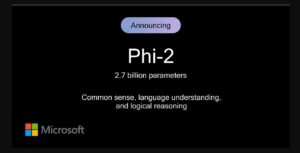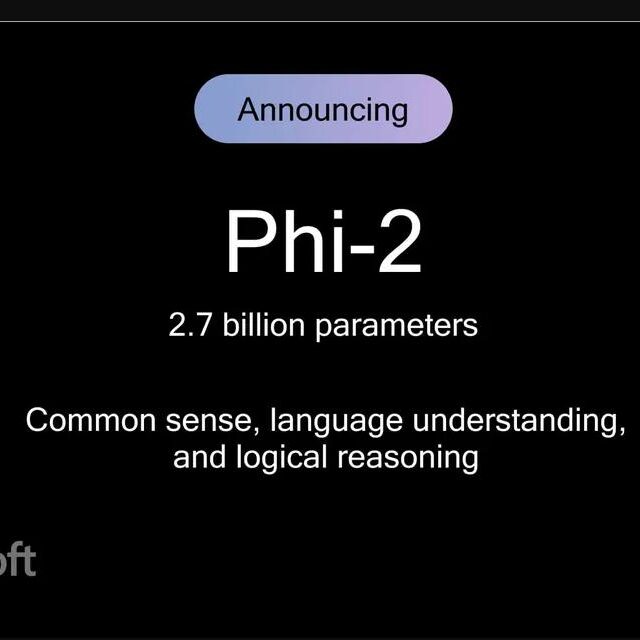Contributors
Marah Abdin, Jyoti Aneja, Sebastien Bubeck, Caio César Teodoro Mendes, Weizhu Chen, Allie Del Giorno, Ronen Eldan, Sivakanth Gopi, Suriya Gunasekar, Mojan Javaheripi, Piero Kauffmann, Yin Tat Lee, Yuanzhi Li, Anh Nguyen, Gustavo de Rosa, Olli Saarikivi, Adil Salim, Shital Shah, Michael Santacroce, Harkirat Singh Behl, Adam Taumann Kalai, Xin Wang, Rachel Ward, Philipp Witte, Cyril Zhang, Yi Zhang

Over the past few months, our Machine Learning Foundations team at Microsoft Research has released a suite of small language models (SLMs) called “Phi” that achieve remarkable performance on a variety of benchmarks. Our first model, the 1.3 billion parameter Phi-1 (opens in new tab), achieved state-of-the-art performance on Python coding among existing SLMs (specifically on the HumanEval and MBPP benchmarks). We then extended our focus to common sense reasoning and language understanding and created a new 1.3 billion parameter model named Phi-1.5 (opens in new tab), with performance comparable to models 5x larger.
We are now releasing Phi-2 (opens in new tab), a 2.7 billion-parameter language model that demonstrates outstanding reasoning and language understanding capabilities, showcasing state-of-the-art performance among base language models with less than 13 billion parameters. On complex benchmarks Phi-2 matches or outperforms models up to 25x larger, thanks to new innovations in model scaling and training data curation.
With its compact size, Phi-2 is an ideal playground for researchers, including for exploration around mechanistic interpretability, safety improvements, or fine-tuning experimentation on a variety of tasks. We have made Phi-2 (opens in new tab) available in the Azure AI Studio model catalog to foster research and development on language models.
Microsoft Research Podcast
Collaborators: Renewable energy storage with Bichlien Nguyen and David Kwabi
Dr. Bichlien Nguyen and Dr. David Kwabi explore their work in flow batteries and how machine learning can help more effectively search the vast organic chemistry space to identify compounds with properties just right for storing waterpower and other renewables.
Key Insights Behind Phi-2
The massive increase in the size of language models to hundreds of billions of parameters has unlocked a host of emerging capabilities that have redefined the landscape of natural language processing. A question remains whether such emergent abilities can be achieved at a smaller scale using strategic choices for training, e.g., data selection.
Our line of work with the Phi models aims to answer this question by training SLMs that achieve performance on par with models of much higher scale (yet still far from the frontier models). Our key insights for breaking the conventional language model scaling laws with Phi-2 are twofold:
Firstly, training data quality plays a critical role in model performance. This has been known for decades, but we take this insight to its extreme by focusing on “textbook-quality” data, following upon our prior work “Textbooks Are All You Need.” Our training data mixture contains synthetic datasets specifically created to teach the model common sense reasoning and general knowledge, including science, daily activities, and theory of mind, among others. We further augment our training corpus with carefully selected web data that is filtered based on educational value and content quality. Secondly, we use innovative techniques to scale up, starting from our 1.3 billion parameter model, Phi-1.5, and embedding its knowledge within the 2.7 billion parameter Phi-2. This scaled knowledge transfer not only accelerates training convergence but shows clear boost in Phi-2 benchmark scores.

Training Details
Phi-2 is a Transformer-based model with a next-word prediction objective, trained on 1.4T tokens from multiple passes on a mixture of Synthetic and Web datasets for NLP and coding. The training for Phi-2 took 14 days on 96 A100 GPUs. Phi-2 is a base model that has not undergone alignment through reinforcement learning from human feedback (RLHF), nor has it been instruct fine-tuned. Despite this, we observed better behavior with respect to toxicity and bias compared to existing open-source models that went through alignment (see Figure 3). This is in line with what we saw in Phi-1.5 due to our tailored data curation technique, see our previous tech report (opens in new tab) for more details on this. For more information about the Phi-2 model, please visit Azure AI | Machine Learning Studio (opens in new tab).

Phi-2 Evaluation
Below, we summarize Phi-2 performance on academic benchmarks compared to popular language models. Our benchmarks span several categories, namely, Big Bench Hard (BBH) (3 shot with CoT), commonsense reasoning (PIQA, WinoGrande, ARC easy and challenge, SIQA), language understanding (HellaSwag, OpenBookQA, MMLU (5-shot), SQuADv2 (2-shot), BoolQ), math (GSM8k (8 shot)), and coding (HumanEval, MBPP (3-shot)).
With only 2.7 billion parameters, Phi-2 surpasses the performance of Mistral and Llama-2 models at 7B and 13B parameters on various aggregated benchmarks. Notably, it achieves better performance compared to 25x larger Llama-2-70B model on muti-step reasoning tasks, i.e., coding and math. Furthermore, Phi-2 matches or outperforms the recently-announced Google Gemini Nano 2, despite being smaller in size.
Of course, we acknowledge the current challenges with model evaluation, and that many public benchmarks might leak into the training data. For our first model, Phi-1, we did an extensive decontamination study to discard this possibility, which can be found in our first report “Textbooks Are All You Need.” Ultimately, we believe that the best way to judge a language model is to test it on concrete use cases. Following that spirit, we also evaluated Phi-2 using several Microsoft internal proprietary datasets and tasks, comparing it again to Mistral and Llama-2. We observed similar trends, i.e. on average, Phi-2 outperforms Mistral-7B, and the latter outperforms the Llama-2 models (7B, 13B, and 70B).
| Model | Size | BBH | Commonsense Reasoning | Language Understanding | Math | Coding |
|---|---|---|---|---|---|---|
| Llama-2 | 7B | 40.0 | 62.2 | 56.7 | 16.5 | 21.0 |
| 13B | 47.8 | 65.0 | 61.9 | 34.2 | 25.4 | |
| 70B | 66.5 | 69.2 | 67.6 | 64.1 | 38.3 | |
| Mistral | 7B | 57.2 | 66.4 | 63.7 | 46.4 | 39.4 |
| Phi-2 | 2.7B | 59.2 | 68.8 | 62.0 | 61.1 | 53.7 |
| Model | Size | BBH | BoolQ | MBPP | MMLU |
|---|---|---|---|---|---|
| Gemini Nano 2 | 3.2B | 42.4 | 79.3 | 27.2 | 55.8 |
| Phi-2 | 2.7B | 59.3 | 83.3 | 59.1 | 56.7 |
In addition to these benchmarks, we also performed extensive testing on commonly used prompts from the research community. We observed a behavior in accordance with the expectation we had given the benchmark results. For example, we tested a prompt used to probe a model’s ability to solve physics problems, most recently used to evaluate the capabilities of the Gemini Ultra model, and achieved the following result:










